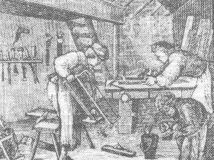


Regional Furniture Society
 |
|
 |
|||
|
Regional Furniture Society |
|||||
|
|
|
||||
West Country Farmhouse and Cottage Furniture.
In September 2002 The Regional Furniture Society organised an exhibition of West Country farmhouse and cottage furniture at Winchester Museum. The aim was to illustrate the distinctive nature of furniture from that region. The exhibits comprised furniture and other related items from the counties of Cornwall, Devon, Dorset, Hampshire, Somerset and Wiltshire; they were selected by Gabriel Olive, who also curated the exhibition.
Gabriel Olive has been researching West Country Furniture for more than 50 years, and his work in the area as an antique dealer over this period has enabled him to observe and record furniture in situ, identifing the subtle differences between one area and another. Through his efforts many rapidly disappearing traditions have been noted. Gabriel's eye for detail and his love of the history behind each piece of furniture has given him an unrivaled knowledge of the subject stylistically, as well as in constructional detail and social context. Over the years he has published many articles, and these have been brought together into a book, Farm and Cottage Furniture in the West Country, published by and available through the Society. Click here for details. The following images and text are drawn from the 2002 exhibition and his work.
In Glynde Path Cottage, Dorchester, April 1884 by Henry Joseph Moule MA, watercolour and pencil.
The settle portrayed here is of typical West Country type, with the shaped end cut from a single board and random width vertical boards forming the back. The cricket (stool) stands under the seat. The space between the settle and the fireplace is filled by a draught screen over which is draped some washing. the chair is a country version of a fashionable type, probably made from fruitwood, with extra heavy stretchers between the legs. placing a pelmet over the fireplace was a common practice, to increase the draught and prevent the chimney smoking.
From the Henry Moule Collection, courtesy of Dorset Natural History & Archaeological Society.
The Background
The range of furniture that was found in West Country Farmhouses and cottages was similar to that found elsewhere. The most important pieces were the long table, the settle and the dresser. There are at least five different types of dresser distinguishable from the region, two of which were included in the exhibition.
Each piece had its own place in the farmhouse kitchen, the table under the window for maximum light, the settle by the fire to create a warm snug area, and the dresser on the opposite wall. Though not generally fixed they always kept their traditional positions. Some farmhouses would have more than one dresser, the one in the kitchen being supplemented by another in the parlour for display of the best china.
The illustration above shows a settle in its traditional place in a Dorchester Cottage. In the West Country and South Wales some settles were made with a cupboard in the back in which could be hung sides of bacon to dry, rather than hanging them in the chimney to be smoked.
Furniture Makers
Much farm and cottage furniture was made within the rural community. Its makers were skilled woodworkers able to make and repair most kinds of farm equipment. Closely bound to the soil they understood the needs of their fellow workers in the fields. The furniture they made was essentially practical.
Methods of construction were more those of the joiner than the cabinet-maker and relied on the natural qualities of the materials being used. The most common timbers were oak, ash and elm, but any other suitable local materials would also be used. There are a number of items of furniture recorded in inventories as being made of wicker or rush. Oak and elm were plentiful and could be converted from the tree into broad planks using a sawpit; smaller sections might be cleft or split.
Many typical West Country pieces are made from these wide boards including settles, dressers and coffers. Coffer is the the local name for the six board chests common in the region. A distinctive feature of these coffers is the notching on the ends of the top and sides; a feature also seen on stools and boxes from the area. Another feature is the 'V' shape cut from the vertical end boards to form feet. On occaiasions the cuts were continued upwards to form a decorative 'X'.
End of a six plank West Country coffer showing the distinctive 'V' cut and decorative 'X' formed by extending the saw cuts.
One specialist furniture trade that did develop was Windsor chairmaking. There was a notable centre of production at Yealmpton in Devon flourishing in the early nineteenth century. The exhibition included several examples of Yealmptom chairs with distinctive 'bamboo' effect turnings on the legs and spindles. There were many other places where chairs were made including a factory at Aldbourne in Wiltshire towards the end of the nineteenth century. In 1909 a childs chair similar to the one shown below would have cost 3s. 6d. (17p) and hundreds were made to supply the County's schools.
[Front Page] [Home] [Membership] [Journal][Bursaries][Contents][News]
© Regional Furniture Society - January 2004